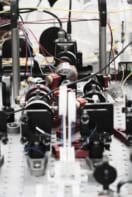An international team of physicists has taken an important step on the road to global quantum communication by demonstrating the basic principle of a quantum repeater. The breakthrough, which marks the first time that two atom clouds have been entangled remotely, could someday be used to counteract decay in quantum signals.
Quantum communication provides a means to transmit information that is fundamentally secure. It requires two parties to be entangled over a quantum channel, over which a “key” for decoding encrypting information can be established. Because this key becomes corrupt as soon as it is used once, the intended receiver can always tell if the key has been intercepted by an eavesdropper.
Although quantum communication has been used already over distances of up to 100 km or so, it is difficult to create entanglement over larger distances because of signal degradation. In classical communication the simple remedy would be to amplify the signal periodically, but this is impossible for quantum keys because of the “no cloning theorem” which precludes a quantum signal from being copied.
Building up entanglement
The answer is the quantum repeater — and now Jian-Wei Pan, Yu-Ao Chen and colleagues from the University of Heidelberg, the University of Science and Technology of China the Vienna University of Technology have demonstrated a crude version of such a device. The idea is that the quantum channel is split up into segments, each of which is easier to entangle. Once the segments are entangled individually they can then be entangled together via the same process.
Pan and colleagues have shown how to entangle one of the segments. They begin with two ultra-cold clouds of rubidium atoms, each of which they entangle with a single photon. The two photons are then sent towards each other via fibre-optic channel. At the middle the photons cross at a beam splitter, and finally the researchers perform a measurement on them to entangle the atom clouds (Nature 454 1098).
The team states in its report in Nature that it has only managed the entanglement of a fibre-optic channel 300 m long, which was limited by a 10 µs lifetime of the atom cloud. However, Chen told physicsworld.com that they have since increased the atom-cloud lifetime to 1 ms, thereby opening the door to a quantum channel 100 km long.
The researchers are presently trying to increase the efficiency from 10% towards unity so that they can couple several of the entanglement segments together.



